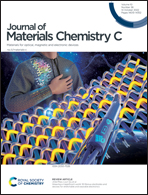Insights into the degradation mechanism of carbene–metal–amide organic light-emitting diodes†
Abstract
Organic light-emitting diodes (OLEDs) based on carbene–metal–amide (CMA) material are fabricated to investigate the fundamental processes that drive degradation in operational CMA OLEDs. The device lifetime of CMA OLEDs decreases rapidly with increased applied current density and implies a bimolecular degradation process. Photo- and electrical degradation studies of unipolar devices show that neither holes nor electrons are involved, and degradation is only driven by excitons. Probing of the recombination zone rationalises the degradation rate in OLEDs. We observe that the rate increases with the square of the exciton density and conclude that the degradation in CMA OLEDs is primarily driven by exciton–exciton annihilation.



 Please wait while we load your content...
Please wait while we load your content...